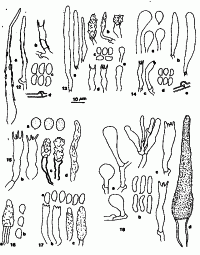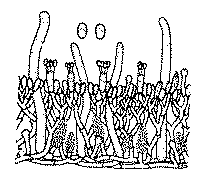|
 Hyphodontia verecunda Hyphodontia verecunda
SynonymsPeniophora verecunda
Palifer verecundus
BiostatusPresent in region - Indigenous. Endemic
Images (click to enlarge)
Caption: Fig. 12-18 , Fig. 12 Peniophora nikau [=Subulicystidium nikau] (PDD 13816), a: cystidia,
b: basidium, c: spores,.d:
basal hypha. Fig. 13 Peniophora verecunda [=Palifer verecundus](PDD 12513), a: leptocystidia, b: encrusted
cystidia, | 
Caption: Fig. 6. Peniophora verecunda G.H.Cunn. Transverse section, x 500. Spores, x 1000. |
Article: Cunningham, G.H. (1955). Thelephoraceae of New Zealand. Part VI. The genus Peniophora. Transactions of the Royal Society of New Zealand 83(2): 247-293.
Description: Hymenophore annual, membranous, adnate, effused forming irregular linear areas 0.5-6 x
0.5-1.5 cm, with numerous scattered outlying islands; surface white, then pallid cream, even,
not creviced; margin thinning out, white, arachnoid, adnate. Context white, 50-70 µ thick,
basal layer of a few repent hyphae, intermediate layer of sparse ascending hyphae branched
more freely in the subhymenium; generative hyphae 3-4 µ diameter, walls 0.25 µ thick,
hyaline, naked, branched, septate, with clamp connexions. Hymenial layer to 25 µ deep, a
palisade of basidia, paraphyses and gloeocystidia. Basidia subclavate, 14-18 x 4-5 µ, 4-spored; sterigmata delicate, erect, to 6 µ long.
Paraphyses subclavate, similar to but shorter
than the basidia. Gloeocystidia arising from the basal layer, projecting for the greater part of
their length; cylindrical. 70-105 x 5-7 µ, apices rounded, walls 0.5 µ thick, collapsing.
Cystidia arising from the basal layer and confined to the intermediate layer, fusiform or
conical. 16-24 x 5-8 µ, coated with deciduous rod-shaped crystals imbricately arranged.
Vesicles scanty, arising from the basal layer and confined to the context, occasionally
appearing as paraphysate hyphae in the hymenium, 16-20 x 4 µ, capitate apices 5-6 µ across.
Spores obovate, oval, broadly elliptical, a few pip-shaped, 5-6 x 3-4 µ, walls smooth, hyaline,
0.2 µ thick.
Habitat: HABITAT. Effused on decayed decorticated wood.
Distribution: DISTRIBUTION. New Zealand.
Notes: From the two preceding species [P. vesiculosa, P. utriculosa] this delicate plant may be
separated by the simple vesicles, small unusual cystidia, and thin-walled projecting
gloeocystidia. Cystidia are confined to the context, fusiform or narrowly conical and coated
with coarse rod-shaped deciduous crystals imbricately arranged. Gloeocystidia are cylindrical,
project for more than half their length, and collapse soon after reaching maturity. Vesicles
arise from the basal layer as simple hyphae with capitate apices. Similar organs are present in
the hymenium, developing as capitate paraphysate hyphae. The specific name has been
chosen to indicate the modest nature of the cystidia.
Article: Stalpers, J.A.; Buchanan, P.K. (1991). Type studies of the species of Pellicularia and Peniophora described by G.H. Cunningham. New Zealand Journal of Botany 29(3): 331-340 (http://www.rsnz.org/publish/abstracts.php).
Description: Basidiome effused, arachnoid to submembranaceous. Subiculum loose, scanty. Basal hyphae
thin- to rarely somewhat thick-walled, up to 4.5(-7) µm wide, sometimes irregularly inflated,
with small, abrupt clamps. Vesicles 3.5-4.5 µm wide. Encrusted hyphae present in subiculum;
the encrustation is irregular, either apical or surrounding intercalary parts of hyphae. Thin-walled
cystidia with large, rodshaped crystals present in the subiculum, originating from
parallel basal hyphae or directly from the wood, 15-32 x 3-5 µm. Leptocystidia cylindrical,
smooth, arising from the subhymeniunn or subiculum, 40-100 x 4.5-6 µm. Basidia rarely
recognisable, subclavate, c. 15-20 x 4 µm, with four sterigmata. Spores hyaline, thin-walled,
smooth, broadly ellipsoid, 4-6 x 2.5-4 x 3.5-4 µm, not amyloid.
Notes: This species does not fit in any described genus. The structure of the basidiome suggests
Botryobasidium Donk, but the morphology of the hyphae, vesicles and encrusted cystidia do
not correspond to this genus. Grandinia Fr. has different hyphae and cystidia. In Fibulomyces
Julich or Leptosporomyces Julich vesicles and encrusted cystidia are unknown. Consequently
a new genus [Palifer] is described:
|